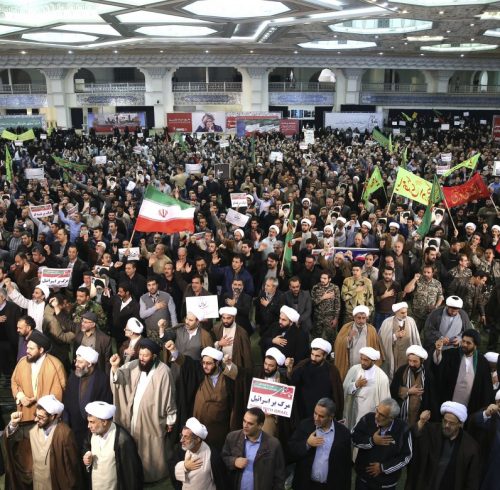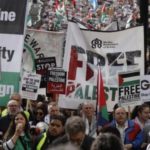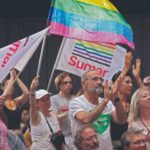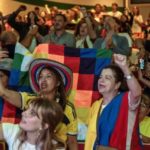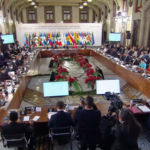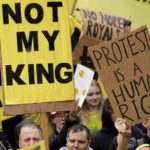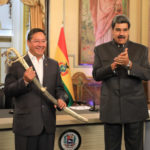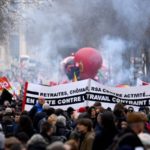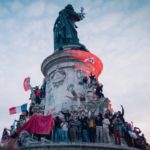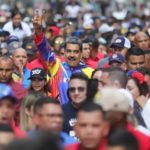The demonstrations in Iran have a base in the low pensions and wages, the rise in fuel prices and the cost of living. Following the first mobilisations against the government, there was a massive response of the population. But in spite of provocateurs lurking among people to make acts of violence, this was not the Green Movement.
The Iranian masses learnt to isolate the counter-revolutionaries through their maturity. They took to the streets in great numbers in big towns like Mashhad, Ardabil, Isfahan, Urmia, Qom and many others. They denounced the interference of Israel, the United States, the United Kingdom, Saudi Arabia and other Western countries. Iran plays a capital role in the Middle East where it supports Syria and Hezbollah. And it sends militias in Iraq, to free the territories that ISIS had captured.
This is why Trump wants to trash the Vienna nuclear agreement with Iran. He increases the US blockade to weaken the important centre which Iran represents in the development of the revolutionary process in the region. The declarations of General Mohammad Ali Jafari, Commander of the Guardians of the Revolution, confirmed that the mass revolt was not allowed to fall to enemies’ hand; showing also the great importance and authority of the Guardians in the present struggle of tendencies. The Guardians’ intervention joined forces with the masses and their resolve. They combined together to defeat the counter-revolutionary provocateurs.
Imperialism and NATO lost the war in Syria. To stop the region stabilising and progressing [against them], the imperialists want to open new fronts. It is to reinforce themselves in the Middle East that they shore up the Saudi-Israel axis.
In Saudi Arabia, the first deputy Prime Minister Mohammad Ben Salman – son and successor of Abdul Aziz, cleans up and concentrates the apparatus of State in preparation for war against Hezbollah and Iran. This is why he dedicates 100 billions dollars to the purchase of modernised weapons, planes and tanks.
This did not serve Saudi Arabia very well in its war on Yemen. Its army was defeated there. The Houthi militias entered Saudi territory and occupied villages for a time, and in the most recent confrontations, the Houthis destroyed Saudi tanks with missiles supplied by Iran and Russia.
The mass mobilisations in Iran are very important. They heighten the anti-imperialist sentiment of the Iranian people. They are a great spur to the struggle throughout the Middle East and the Arab world.
Chronicle from our correspondent in Iran: Letters from 21.12.17 – 04.01.18
21.12.2017 – There is open war in Iran. On 19 December 2017, Ahmadinejad called on the Head of Judicial Power, Sadeq Amoli Larijani (who is also the brother of the parliamentary speaker Ali Larijani), to give up his post or be removed. Elsewhere, a judge condemned Hamid Baghaie (in his absence) to 63 years in jail for having accused Sadeq Amoli of owning 63 bank accounts where money seems to flow every time a billionaire gets the death penalty [1]. Whatever message was behind the 63 years jail-term, the accused got it at the correct address.
The price of oil passed from 1,000 to 1,500 rials, and there were already revolts against this savage increase when people were told that it was only a proposal. Now that the government is cutting other subsidies, expect more revolts and protests…
26.12.2017 – The Iranian parliament is discussing the government’s budget for the next four years. More cuts in family subsidies are coming. People are told that jobs will be created with the money, plus the 50% rise in the price of fuel. Not explained is the method that will create one million new jobs. Unexplained too is why the billions thus saved are not accounted for in the draft budget. This sort of thing is not special to Iran. All the neoliberal governments do this, to stimulate the private sector. But people are not fooled by this populist demagogy.
27.12.2017 – The Supreme Leader of Iran Ali Khamenei has attacked Ahmadinejad and his group. The latter are said to have offended the power of the judiciary [2], but this creates an impasse just when the conditions exist for a leap forward. Khamenei recognises bi-polarity in religious concepts between good and bad, but not between Mazda and Ahriman in the concepts of ancient Zoroasrianism [3]. He only deals with the just and the unjust, avoiding in this way a direct confrontation with those at the top of Iranian power.
The 30th of December coming will commemorate the day when the Iranian masses rose spontaneously and stopped eight months of the counter-revolutionary ‘Green Revolution’ (2009-2010). It is a fact however that those who took part in this ‘coloured’ revolution are now at the head of the Executive and Legislative. As for the Judiciary, its power is terrible, beyond reach. Its chief Sadeq Amoli Larijani is a direct nominee of Khamenei. No one knows if he is in charge of the judicial apparatus or not. Rumours have circulated about the arrest of several imperialist spies; it is said that President Hassan Rouhani and the intelligence chiefs wanted their liberation. One of them, Ahmadreza Djalabi [4] was sentenced to death. The British Foreign Affairs Minister Boris Johnson came to Teheran last week in order, or so it is said, to stop their condemnations and to have them released.
The judges finally arrested – and then freed – the brother of President Rouhani – as well as Eshaq Jahangiri, brother of the Vice President. These people speak ill of [persons like] Chavez. They attack Ahmadinejad; they smear his team and they handed down a 63 years jail sentence to Hamid Baghaie (of Ahmadinejad’s team).
Ahmadinejad is touring the country. He is very welcome by the people who rebel against the great abuses of power, the injustices, the misery and the high prices. What is Khamenei going to do? Is he going to demand his return? If so, those who already want Ahmadinejad’s scalp will go further on the offensive; but Ahmadinejad wont give up. Tomorrow he goes to Bushehr, the town of the nuclear power stations, where the Russians are [5] …
30.12.2017 – The earthquakes continue – the geological, the political and the social ones. Today is the day that commemorates the popular rising of 8 years ago, when the masses ended the ‘coloured coup’ that blocked the re-election of Ahmadinejad. Celebrations are to take place in 2,100 towns. The rallies always end up with resolutions against imperialism, the US, the UK, Israel. In Teheran, Ayatollah Mohsen Araki says that the situation that existed before the nuclear accords is coming back. These accords failed, he says, because the US did not respect them. Should this view start spreading, it will weaken Rouhani and the gist of his foreign policy.
Although this is not said outright, the government is accused of flirting with the enemy; and this, for results that cannot be obtained. A return to the pre-accords situation would allow enriching uranium again for the production of electricity, and (at 20%) for the hospitals. One would work again on satellites and missiles. Much depends on Trump in this matter because he acts in ways that seek a rupture with Iran.
In today’s rallies, orators could be heard berating “the ghosts who conspire internally” (ie. from within the country). This might have aimed at Ahmadinejad [6], but not necessarily, because things have changed in the last two days. It is important that matters of international policies are coming up in speeches alongide concerns about “the economic plot” of raised prices, thieves and overpaid directors within the country. This happens in most major towns – shaking Iran, more every day, from East to West.
Some big demonstrations against corruption, against the economic crisis and against unemployment had not been official. And when provocateurs found their way in them, they were egged on by the Western media and Trump’s declarations. This did not go down well with the Iranian authorities. Reactionaries from various parts accused Amadinejad of having fomented or provoked these demonstrations. They accused him of scheming. Some days before, even Khamenei had reproved Ahmadinejad sharply, although without referring to any particular. But then, Khamenei himself did not defend the power of the Judiciary. The latter had been the target of the ‘three musketeers’ around Ahmadinejad.
In one of the towns where massive popular demonstrations happened, the orator was a Pasdaran leader. He spoke against the United States. The Pasdaran (Guardians of the Revolution) intervene directly and politically at the highest level. They hold continuous meetings with Khamenei, leaving parliament to debate the very unpopular budget of the government.
The parliament cannot remain impervious to the protests and the popular mobilisations. The early protests had been about economic and internal matters in the main. Now they have slogans of international politics, and the two tend to merge. In Mashhad, 2nd town in Iran, where the tendency was to criticise Ahmadinejad for his doggedness against the corrupt and arrogant apparatuses – like the Judiciary and its chief – people did not follow the official line of attack on Ahmadinejad.
In the demonstrations of an economic character, imperialism fans the flames of protest by trying to give them an ethnic turn. This will not work, however. Even in Kurdistan and in Sanandaj (capital of the Iranian Kurdistan), those who demonstrated supported Khamenei against imperialism. The process is combining; the powerful demonstrations incline towards a social synthesis, a revolutionary policy. One cannot know at costs because groups lurk around, looking for ways to provoke, to threaten, to throw bombs at parliament [7] …
31.12.2017 – Ahmadinejad has long been talking of his surprise at the government’s economic provocations, perhaps in the expectation of a popular reaction. The Pasdaran say that they are ready to intervene [against the economic provovations] but the Minister of the Interior, a regular provocateur himself, says “no”. Many social media channels have now been banned or put under control. This includes Telegram, an app used by Ahmadinejad.
01.01.2018 – The 40% increase in the price of eggs provoked popular anger; but similar protests have gone on for years, not just in the last 3 or 4 days. In all the regions people oppose the speculators and the super-privatisers in the government. This Rouhani government shares the ‘colour’ of the ‘Green Revolution’ of eight years ago. Those who caused the rise in the price of eggs went promptly into hiding. It is curious that Iran, formerly an eggs exporter has suddenly become an importer.
This new provocation failed in matter of days. At each attack on Iran, the country gets nearer to the settlement of accounts that has been coming for years.
02.01.2018 – Ali Khamenei appeared in public today with a tranquil appearance. People had understood the sense of the provocations because they did not fall into the trap. Isolated groups took to violent action, attacking even the demonstrators themselves! These were not youngsters from the cities’ popular areas. They were from outside, shooting and killing. Killing from a distance and getting the security services blamed. They attacked places of worship and police stations. They destroyed flags of the Islamist Republic and photos of Khamenei. They are supported by imperialism. They looked for ways to enter the demonstrations to infuriate and battle. They failed in this however, because Iran has the experience of years in this matter, not that of a few days. There seemed to be two kinds of provocateurs: one wanting the State to explode or implode – with the help of foreign and imperialist intervention – and the other using blackmail and intimidation to keep the confrontations escalating.
Sadeq Amoli Larijani of the Judiciary uses blackmail himself. He says that people have their own demands, but that official rules must be followed. If not, you get violence and counter-violence, and those in power are obliged to use force. Now he looks for scapegoats to keep people intimidated.
The sudden rise in the price of eggs seemed the last drop in the vase, but it was used as pretext by violent groups to excite and provoke people, to start fires and etc. – everything the same as 8 years ago.
Saturday was the anniversary of the day when, in 2010, the masses rose to break the ‘coloured’ revolution that stopped Ahamdinejad’s re-election. Khamenei took to the podium. In his speech, he targeted mostly those who had trusted imperialism. He targeted those who had trusted in accords with the United States that the latter do not respect.
The provocations come from powerful circles inside the government. They want to stop the spiralling advance [of the people] against them. The provocations in the streets work like the bombs found deposited in parliament in 2010. The latter were not meant to explode. Behind their shock and blackmail, the intention was to usher-in a second Rouhani administration. And this is what happened.
02.01.2018 – The plans for a government budget and financial laws are neoliberal. More cuts in subsidies are announced, and the prices will be allowed to rise. Parliament however is more open pressure from below. It won amendments to the budget for instance. It reinstated some of the subsidies on petrol and medicines. And this is not finished because members of parliament insist on better deals for the population.
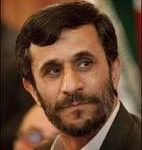
Still touring the country, Ahmadinejad says: “Down with this government” – Out!
Had the government been strong, it would have decreed a State of Emergency. It did not because it cannot. The radio announced this morning that provocateurs shoot people from a distance. They kill people to get the security forces blamed. They are not from the areas, but from elsewhere. Some have been identified but not arrested; others are identified and arrested only after delays.
The Pasdaran offered to deal with this, but the Minister of the Interior Abdoulreza Falzi did not allow them. Whilst the minister takes his time in clamping down on the provocations, he quickly closes down the social media apps. The canal Amadnews that kept inciting and organising acts of violence (even showing how to make rudimentary bombs and start fires!) had nothing done against it up to two days ago; but Ahmadinejad’s site was closed last month.
The provocations started on the 29th December – the following day (30th) being when the masses were going to commemorate their victory over the ‘coloured’ revolution 8 years ago. On the 30th, protests appeared against the government’s economic measures in the midst of those commemorating. But the government’s economic measures were not a few days old, they had been around for months. These were the months when Ahmadinejad had criticised the power of the Judiciary; when he had demanded the resignation of the Chief Judge, that of the Teheran Judge, and that of others implicated in shady affairs.
The situation in the country has long been on the brink of rupture. On a one hand, you have the reactionary and corrupt apparatus of the institutions, along with a business (affairist) bourgeoisie and the new rich from domestic and international banks. These are represented by the government, along with some well-off petit bourgeois, intellectuals, academics and cineastes. What you find on the other hand is the revolutionary forces: the National Army, the Pasdaran, the Militias and the huge popular masses of Iran.
The present equilibrium could give way and at the expense of the government. The Judiciary stands between the rock and a hard place. It must attack the revolutionary « justicialist » tendencies like that of Ahmadinejad, but it must also arrest very corrupt people like the brothers of the President and Vice-President. The attack of the suicide-bombers inside parliament and near Khomeiny’s shrine in June 2017 served to frighten and muddy the waters – as in 2010. The bombs in parliament in 2010 had hung over the situation like a Damocles sword to secure a second term for Rouhani. His return was not through re-election: a sector of the apparatus imposed itself on the other by force.
However, the international situation had been changing during the first four years of the Rouhani government. The imperialist camp – working through Daesh ISIS – was defeated in the Middle East – and Donald Trump was elected in the United States. The new US policy deepened the crisis of Rouhani’s foreign policy. The failure of the nuclear accords [to the detriment of Iran] showed how correct Khamenei had been in opposing them.
Six months after Rouhani’s re-election, he comes up with a budget of neoliberal measures and privatisations. No more subsidies for the working-class families, although they need this money to pay for water, gas and electricity; and 125 remedies to be removed from the controlled price-list. Certain payments which the workers are entitled to receive from their employers are also to be stopped.
The government encourages the privatisation of the country’s ports. Under Rouhani, the number of large and productive State enterprises has halved, and the big mixed enterprises are being stifled. The banks are handed over to the private sector. Imports come in freely and massively. This free and massive entry of imported goods causes the closure of the national enterprises. Rouhani’s administration has crippled and partly closed the great Pasdaran plant of Garargah Sazandeghi, an installation that comprises “Southern Star”, the biggest refinery of the Middle East. The latter was at 90% of its completion and once finished, Iran was going to be self-sufficient in fuel production and consumption.
The list is long of the works that are stalled or abandoned, particularly affecting the building of popular housing, along with the North-South railway line, the Eastwards “Peace” gas pipeline and the nuclear power stations for the production of electricity.
The 30th December commemoration heralded a political shift and a rupture with the policy of conciliation of the government. A little before that day, Khamenei had reprimanded forcefully those who “had wanted to shake the iron fist of imperialism in its velvet glove”. This had been aimed at the Rouhani government.
The chief of the Judiciary Amoli Larijani was amongst those who eased the path of provocateurs. He said that people should be allowed to speak up officially instead of in the streets – to lessen the risk of provocations he said. Having understood this properly, the people stayed in the streets. In the end, parliament made important improvements to the budget, compared with the original plan. The plan’s most anti-popular aspects are being dropped, like the price-rise on gas, water and electricity. The subsidies will continue, the price of fuel will not go up: yesterday’s plan has morphed into a new one. Ahmadinejad called publicly for the resignation of the government.
03.01.2018 – Five days after the original big demonstrations (in 1,200 towns), there are now new and powerful ones where people say that they want to stop the ‘lumpen elements’ of the social and intellectual sorts. The characters who poured oil on the fires of the demonstrations are now seeing the flames turning against them. These new popular mobilisations are greater and more compact than ever; they regroup Iranians, Persians, Kurds, Gilaks[8], Arabs and Baluchs[9]. All these groups express firm solidarity with Khamenei. In the most recent events, the Pasdaran were amongst them, along with the Basij (Popular Militia) and the National Army. Their concentrated force broke the back of the reactionary and counter-revolutionary opposition. Note that this opposition is not just a handful of provocateurs. It has its core in the institutional apparatus of the State and in some parts of the government.
The chief of the Pasdaran Mohammad Ali Jafari [10] was first on the ground to declare the counter-revolutionary provocations over and dealt with. The US ambassador to the United Nations Nikki Haley overshot her hands when her eight-years-old mantra “for democracy and social rights” stood up in all the cities of Iran to defend the Revolutionary State and its guide Khamenei.
This is a turning point, even if what should happen does not do so automatically. In the hands of the parliament, the government’s budget and financial law have lost their most anti-popular and liberal features. The impact is going to be immediate as the government is forced to backtrack on its economic policies. In the medium term, there will be consequences too for those in posts of responsibility in the departments.
04.01.2018 – There is a remarkable crisis in the European media. These always supported Rouhani, but now they wonder about him. Some North American and French leaders are not keen on the nuclear agreements being scrapped. France has interests in the oil industry of Iran. It wants to replace Italy which was once the important industrial partner of Iran. The historic stupidity of Macron leads him to draw closer to Trump; as a result. he now says that the restrictions imposed on Iran should be extended to missiles and space research. For these people, the intervention of Iran against Daesh ISIS has counted for nothing.
Letters from our correspondent in Iran – (Extracts).
[1] As in the case of Mah Afaridi.
[2] Ahmadinejad and Baghaie (former President and Vice President of Iran) were told not to stand in the presidential elections of May 2017. Ahmadinejad did it anyway, incurring some wrath from Khamenei.
[3] This refers to Ahura Mazda, the God in the Universe of Zoroasrianism. He has two children: one is Mazda, the holy spirit and the other is Ahriman, the destructive one.
[4] Ahmadreza Djalabi: a physician and researcher affiliated to the Institute Karolinska of Stockholm. He is accused of collusion with enemy forces. He was jailed in April 2016 and condemned to death. To date, the sentence has not been carried out.
[5] In October 2017, Russia and Iran started construction work on the BushehrTwo nuclear plant.
[6] Ahmadinejad stood for President in the 2017 May election against the wishes of Khamenei. This provoked anger against him on the part of official orators on 30.12.2017.
[7] On 27.7.2017, more than 12 persons were killed by 6 suicide-bombers who attacked the Iranian parliament and the tomb of the Ayatollah Khomeini.
[8] Gilaks: An Iranian ethnic group in the North of Iran, with its own language.
[9] The Baluch are sometimes called Baloch. They live in the South-East of Iran.
[10] General Mohammad Ali Jafari is the commander of the Revolutionary Guard of Iran. He was appointed in Sept 2017, replacing Yahya Rahim Safav.
